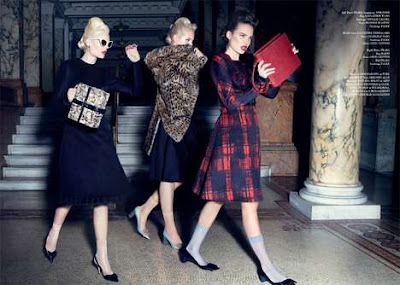
Kershaw by Slimane Vogue Russia April 2011
A viewer recently commented on a post on Roland Barthes' text on fashion photography. The text, from Barthes' Fashion System, is where he lays out how fashion photos work. He describes the world as a backdrop, that sets the stage for an exorcism in which everything is made unreal but the clothing. The unreal images leave us clinging to the clothes as the only recognizable sign of reality.
Barthes' named 3 types of fashion photos that dominate - literal, romantic and mocking. I often test Barthes' theory to see if the 3 types are still common since he first described them in 1967.
Above and below are what Barthes called literal representations. These are catalog and look book shots that do nothing more than present the clothing directly or on a model, typically in studio.
Above the image exposes the contrived world of the fashion studio, concurrent with the rise of reality consciousness in general. More and more street photography is being used for literal representation.

Garrn by Akrans for Harper's Bazaar April 11
When the reality shots become more involved and suggest a specific narrative they become a second style, what Barthes explained as the romantic, which is more surreal and referential. Editorials by Steven Meisel are frequently of this type. Below Meisel's editorial based on Bergman's Persona.

Above and below Meisel for Vogue Italia, "Cottage by the Sea," November 2008
As editorials become more complex and absurd, they use unusual props and juxtapositions. For Barthes this is the style of mockery. With a camp sensibility, these editorials take reality to extremes by challenging assumed situations and making them humorous.
Above the classic animal prop toys with formality and below the chaos of total absurdity.

50 years after Barthes it is easy to find images that fulfill the 3 categories of literal, romantic and mockery. But there are also many photographs that cross these categories.
Below for example, the models, present the clothing in clear literal form, they enact a dream like sequence of facing the press but are more dramatic in a camp like effort that mocks the contemporary aspect of paparazzi.
The same collision of all 3 styles is seen below in Meisel's work. The clothing is shown literally, the editorial is romanticized with a bit of an over the top emphasis that mocks a genuine reality. Perhaps in the collision of all 3 styles, the ultimate fashion photo is achieved.

Meisel, 4 Days in LA, 2001
The best of Barthes is his understanding of the misunderstanding in the fashion photo. Fashion photography ultimately creates a disappointment of meaning by its establishment of the mystery that has no resolution. It produces meaningful signs but does not offer explanation. The 3 types of fashion photos all result in the same lack of meaningful fulfillment. For the advertisement, the purchase of the clothing resolves the image. For the editorial, actual lifestyle transformation is the resolution.






No comments:
Post a Comment